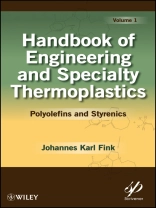Utilizes an encyclopedic approach to cover the developments in
polyolefins and styrenics during the last decade
This book focuses on common types of polymers belonging to the
class of polyolefins and styrenics. The text is arranged according
to the chemical constitution of polymers and reviews the
developments that have taken place in the last decade. A brief
introduction to the polymer type is given and previous monographs
and reviews dealing with the topic are listed for quick reference.
The text continues with monomers, polymerization, fabrication
techniques, properties, application, as well as safety issues.
Providing a rather encyclopedic approach to polyolefins and
styrenics, The Handbook of Engineering and Specialty
Thermoplastics:
* Presents a listing of suppliers and commercial grades
* Reviews current patent literature, essential for the engineer
developing new products
* Contains as extensive tradenames index with information that is
fairly unique
* Concludes with an index of acronyms
The Handbook of Engineering and Specialty Thermoplastics:
Polyolefins and Styrenics provides a comprehensive reference
for chemical engineers and offers advanced students with a textbook
for use in courses on chemically biased plastics technology and
polymer science.
polyolefins and styrenics during the last decade
This book focuses on common types of polymers belonging to the
class of polyolefins and styrenics. The text is arranged according
to the chemical constitution of polymers and reviews the
developments that have taken place in the last decade. A brief
introduction to the polymer type is given and previous monographs
and reviews dealing with the topic are listed for quick reference.
The text continues with monomers, polymerization, fabrication
techniques, properties, application, as well as safety issues.
Providing a rather encyclopedic approach to polyolefins and
styrenics, The Handbook of Engineering and Specialty
Thermoplastics:
* Presents a listing of suppliers and commercial grades
* Reviews current patent literature, essential for the engineer
developing new products
* Contains as extensive tradenames index with information that is
fairly unique
* Concludes with an index of acronyms
The Handbook of Engineering and Specialty Thermoplastics:
Polyolefins and Styrenics provides a comprehensive reference
for chemical engineers and offers advanced students with a textbook
for use in courses on chemically biased plastics technology and
polymer science.
Table of Content
Preface.1 Metathesis Polymers.
1.1 Monomers.
1.2 Polymerization and Fabrication.
1.3 Properties.
1.4 Fabrication Methods.
1.5 Fluorinated Polymers.
1.6 Special Additives.
1.7 Applications.
1.8 Suppliers and Commercial Grades.
1.9 Safety.
References.
2 Cyclic Olefin Copolymers.
2.1 Monomers.
2.2 Polymerization and Fabrication.
2.3 Properties.
2.4 Applications.
2.5 Suppliers and Commercial Grades.
2.6 Safety.
2.7 Environmental Impact and Recycling.
References.
3 Ultra High Molecular Weight Poly(ethylene).
3.1 Monomers.
3.2 Polymerization and Fabrication.
3.3 Properties.
3.4 Special Additives.
3.5 Applications.
3.6 Suppliers and Commercial Grades.
3.7 Safety.
References.
4 Poly(methyl)pentene.
4.1 Monomers.
4.2 Polymerization and Fabrication.
4.3 Properties.
4.4 Applications.
4.5 Suppliers and Commercial Grades.
References.
5 Ionomers.
5.1 Monomers.
5.2 Polymerization and Fabrication.
5.3 Properties.
5.4 Special Additives.
5.5 Applications.
5.6 Suppliers and Commercial Grades.
References.
6 Poly(isobutylene).
6.1 Monomers.
6.2 Polymerization and Fabrication.
6.3 Properties.
6.4 Special Additives.
6.5 Applications.
6.6 Suppliers and Commercial Grades.
6.7 Environmental Impact and Recycling.
References.
7 Ethylene Vinyl Acetate Copolymers.
7.1 Monomers.
7.2 Polymerization and Fabrication.
7.3 Properties.
7.4 Applications.
7.5 Suppliers and Commercial Grades.
References.
8 Acrylonitrile-Butadiene-Styrene Polymers.
8.1 Monomers.
8.2 Polymerization and Fabrication.
8.3 Properties.
8.4 Special Additives.
8.5 Applications.
8.6 Suppliers and Commercial Grades.
8.7 Safety.
8.8 Environmental Impact and Recycling.
References.
9 High Impact Poly(styrene).
9.1 Monomers.
9.2 Polymerization and Fabrication.
9.3 Properties.
9.4 Special Additives.
9.5 Applications.
9.6 Suppliers and Commercial Grades.
9.7 Safety.
9.8 Environmental Impact and Recycling.
References.
10 Styrene/Acrylonitrile Polymers.
10.1 Monomers.
10.2 Polymerization and Fabrication.
10.3 Properties.
10.4 Special Additives.
10.5 Applications.
10.6 Suppliers and Commercial Grades.
10.7 Environmental Impact and Recycling.
References.
11 Methyl methacrylate/Butadiene/Styrene Polymers.
11.1 Monomers.
11.2 Polymerization and Fabrication.
11.3 Properties.
11.4 Special Additives.
11.5 Applications.
11.6 Suppliers and Commercial Grades.
References.
12 Acrylonitrile/Styrene/Acrylate Polymers.
12.1 Monomers.
12.2 Polymerization and Fabrication.
12.3 Properties.
12.4 Special Additives.
12.5 Applications.
12.6 Suppliers and Commercial Grades.
References.
Index.
Tradenames.
Acronyms.
Chemicals.
General Index.
About the author
Johannes Karl Fink, Ph D is Professor of Macromolecular Chemistry at Montanuniversitãt, Loeben, Austria. His industry and academic career spans more than 30 years in the fields of polymers, and his research interests include characterization, flame retardancy, thermodynamics and degradation of polymers, pyrolysis, and adhesives. Professor Fink has published several books on physical chemistry and polymer science including A Concise Introduction to Additives for Thermoplastic Polymers (Wiley/Scrivener-2010).Buy this ebook and get 1 more FREE!
Language English ● Format EPUB ● Pages 400 ● ISBN 9781118029282 ● File size 4.1 MB ● Publisher John Wiley & Sons ● Published 2010 ● Edition 1 ● Downloadable 24 months ● Currency EUR ● ID 2351348 ● Copy protection Adobe DRM
Requires a DRM capable ebook reader










